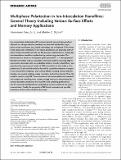Multiphase Polarization in Ion‐Intercalation Nanofilms: General Theory Including Various Surface Effects and Memory Applications
Author(s)
Tian, Huanhuan; Li, Ju; Bazant, Martin Z
DownloadPublished version (6.825Mb)
Publisher with Creative Commons License
Publisher with Creative Commons License
Creative Commons Attribution
Terms of use
Metadata
Show full item recordAbstract
Ion concentration polarization (CP, current‐induced concentration gradient adjacent to a charge‐selective interface) has been well studied for single‐phase mixed conductors (e.g., liquid electrolyte), but multiphase CP has been rarely addressed in literature. In our recent publication, we proposed that CP above certain threshold currents can flip the phase distribution in multiphase ion‐intercalation nanofilms sandwiched by ion‐blocking electrodes. This phenomenon is known as multiphase polarization (MP). It is then proposed that MP can further lead to nonvolatile interfacial resistive switching (RS) for asymmetric electrodes with ion‐modulated electron transfer, which theory can reproduce the experimental results of LTO memristors. In this study, a comprehensive 2D phase‐field model is derived for coupled ion‐electron transport in ion‐intercalation materials, with surface effects including electron transfer kinetics, non‐neutral wetting, energy relaxation, and surface charge. Then, the model is used to study MP. Time evolution of phase boundaries is presented, and analyze the switching time, current, energy, and cyclic voltammetry, for various boundary conditions. It is found that the switching performance can be improved significantly by manipulating surface conditions and mean concentration. Finally, the prospects of MP‐based memories and possible extensions of the current model is discussed.
Date issued
2023-06Department
Massachusetts Institute of Technology. Department of Chemical Engineering; Massachusetts Institute of Technology. Department of MathematicsJournal
Advanced Functional Materials
Publisher
Wiley
Citation
Adv. Funct. Mater. 2023, 33, 2213621
Version: Final published version